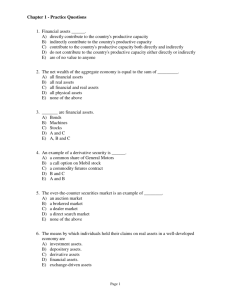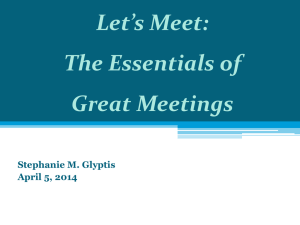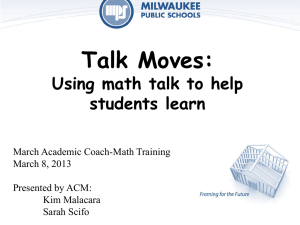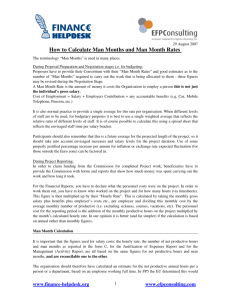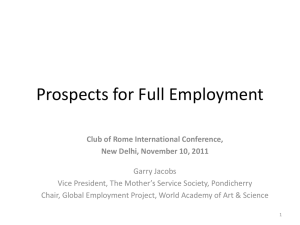Organizing Productive Resources to Make a Profit
advertisement
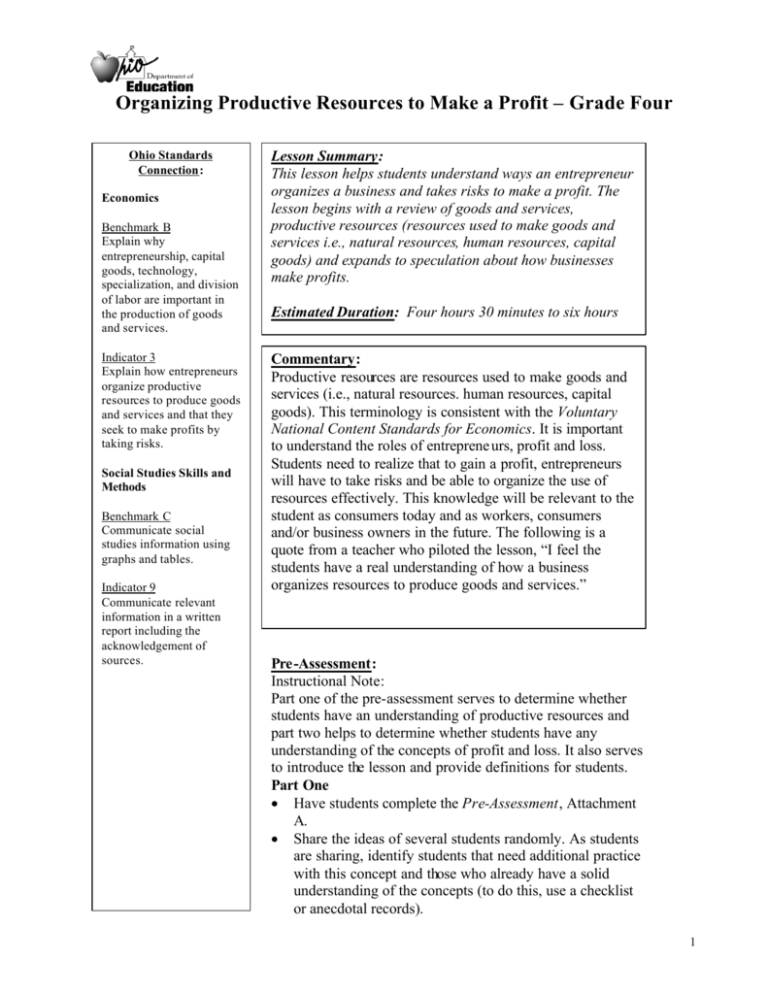
Organizing Productive Resources to Make a Profit – Grade Four Ohio Standards Connection: Economics Benchmark B Explain why entrepreneurship, capital goods, technology, specialization, and division of labor are important in the production of goods and services. Indicator 3 Explain how entrepreneurs organize productive resources to produce goods and services and that they seek to make profits by taking risks. Social Studies Skills and Methods Benchmark C Communicate social studies information using graphs and tables. Indicator 9 Communicate relevant information in a written report including the acknowledgement of sources. Lesson Summary: This lesson helps students understand ways an entrepreneur organizes a business and takes risks to make a profit. The lesson begins with a review of goods and services, productive resources (resources used to make goods and services i.e., natural resources, human resources, capital goods) and expands to speculation about how businesses make profits. Estimated Duration: Four hours 30 minutes to six hours Commentary: Productive resources are resources used to make goods and services (i.e., natural resources. human resources, capital goods). This terminology is consistent with the Voluntary National Content Standards for Economics. It is important to understand the roles of entreprene urs, profit and loss. Students need to realize that to gain a profit, entrepreneurs will have to take risks and be able to organize the use of resources effectively. This knowledge will be relevant to the student as consumers today and as workers, consumers and/or business owners in the future. The following is a quote from a teacher who piloted the lesson, “I feel the students have a real understanding of how a business organizes resources to produce goods and services.” Pre-Assessment: Instructional Note: Part one of the pre-assessment serves to determine whether students have an understanding of productive resources and part two helps to determine whether students have any understanding of the concepts of profit and loss. It also serves to introduce the lesson and provide definitions for students. Part One • Have students complete the Pre-Assessment, Attachment A. • Share the ideas of several students randomly. As students are sharing, identify students that need additional practice with this concept and those who already have a solid understanding of the concepts (to do this, use a checklist or anecdotal records). 1 Organizing Productive Resources to Make a Profit – Grade Four • Optional: Provide students with small pictures to symbolize the steps in making a chair. Ask them to arrange (organize) the pictures in order from the first resource to the final resource (See Attachment B for the answer key). Have students glue their pictures onto a piece of construction paper when they have the correct order displayed on their desks. This part of pre-assessment serves to determine if students have any understanding of organizing productive resources to make goods. Part Two • Ask students why someone starts a business. List their ideas on a chart or the overhead projector. Scoring Guidelines: Use the student ideas generated, the information from the class discussion and teacher judgment to determine the level of knowledge of your students and to differentiate and guide your instruction. Some students will need activities to review the concepts of productive resources, others will be reminded of the definitions through the pre-assessment activity and others will need activities to enrich their understanding. Post-Assessment: The post-assessments serve to provide students with an opportunity to synthesize the information gained from this lesson and to create a product that demonstrates the level of their understanding. The purpose is to show how entrepreneurs use productive resources in their businesses, the reason that they start businesses is to make a profit and that there are risks involved in this endeavor. • Have the students write a feature story for Ohio Entrepreneur Magazine. • Have students complete the Productive Resources Web, Attachment C and the Note-Taking Chart, Attachment H, to gather and organize information for their news story. The productive resource web will help students see how the business they selected must use resources in all three productive resource categories (capital, human resources, natural resources). The notetaking chart will help students organize their research data. • Tell students that their feature stories need to include: 1. Facts about the entrepreneur and his or her business (including what goods and/or services are produced). 2. An explanation of the risks the entrepreneur took to become successful. 3. An explanation of what productive resources that business uses (capital, human resources, natural resources). 4. An explanation of how that entrepreneur seeks to make a profit and what factors have an effect on profit. 5. News story basics: who, what, where, when, why, and how. 6. A bibliography acknowledging your sources that must be in an accepted bibliographic format. Scoring Guidelines: Use the post-assessment to determine your students’ understanding of productive resources and opportunity costs. See Attachment D for a suggested rubric that mirrors the criteria for a feature news story listed above. 2 Organizing Productive Resources to Make a Profit – Grade Four Instructional Procedures: 1. Have students complete section one of the chart How Different Businesses Use Productive Resources in Different Ways, Attachment E. Have the students organize the resources needed to produce a chair. In the chart, have the students write the word for each resource. See Attachment F, Sample Answers. 2. Lead a class discussion about the ideas in the charts. Have students share rationales for each choice. 3. Discuss: “We organize productive resources to accomplish goals.” Ask students, “What is the main goal for businesses?” (to make a profit). Have the students complete numbers two and three on their worksheet How Different Businesses Use Productive Resources in Different Ways, Attachment E. Discuss and share student responses (see Attachment F, Sample Answers). Help students understand that different businesses use productive resources in different ways based upon their business goals. 4. Discuss: “What risks might be faced when you start and run a business?” Have students think of risks that might be associated with starting a business. Then, have students read each statement card provided in Attachment G, Risk Statement Cards. Sort these cards into two categories – risk and not a risk. Discuss sorting choices. 5. Discuss what can happen if the business doesn’t function as planned. What happens if a business doesn’t make a profit? Does a business make a profit in the first year? (Typical businesses take several years to start making a profit.) 6. Ask students to explain how each risk you identified will help increase profits (making money). 7. Define and discuss: a. Entrepreneur - an individual who organizes the use of productive resources to produce goods or services. b. Profit - income less all costs equals profit. c. Risk - a chance of encountering loss. d. Productive resources - the resources used to make goods and services (i.e., natural resources, human resources, capital goods). Instructional Tip: Some ideas to include in your class discussion include competition, new product development, the opportunity cost of producing a particular product and not a different one, availability of productive resources and business statistics such as one out of 10 restaurants fail. 8. For the post-assessment, have the class generate a list of entrepreneurs and businesses. Provide students with a list you have created based upon a keyword Web search. Post this list in the classroom. 9. Divide the class into small groups (three to four students), have groups select a business from the class list to research. Have students create a Productive Resources Web (see Attachment C) that includes business, human resources, natural resources, and capital. Have students organize the productive resources associated with the selected business into these three categories. This web will be used to complete the post-assessment. Inform students that some businesses don’t have one owner (entrepreneur), but are owned by stockholders who have shares in the company. 10. Give each group a copy of the Note-Taking Chart, Attachment H, for the post-assessment. 3 Organizing Productive Resources to Make a Profit – Grade Four 11. Have students use these two worksheets, Attachments C and H, to help them organize the information they gather for their feature news article. Model how to complete these two worksheets. 12. Periodically check the progress of all students. Arrange ind ividual or group conferences to discuss progress and provide feedback. If needed, adjust assignments accordingly after these progress checks. Differentiated Instructional Support: Instruction is differentiated according to learner needs, to help all learners either meet the intent of the specified indicator(s) or, if the indicator is already met, to advance beyond the specified indicator(s). • Students could work independently on their post-assessment project if they prefer, especially those students who want more challenging assignments. • Students who have a more difficult time researching and gathering information could be given a business that has information readily available (nationally known businesses, typically). • Some students may create a better post-assessment project if permitted to use a slide-show format. Use the slide show computer program available in your school district. • Students with reading difficulties may need partners to read aloud information. Be sure the partner is able to assist without enabling. Partners can also check each other’s work. • Parts of this lesson may require note-taking skills. Students who have difficulty with this skill may need the assistance of a peer note-taker. You may also choose to provide some students with a copy of your notes or overhead charts. • Additional time may be required for some students in order to properly complete the postassessment. • To move students beyond the indicator, arrange for a business mentor. Perhaps some students can shadow their mentors to learn first hand about a particular business. This experience will provide students with an opportunity for real-world investigations and learning. Extensions : • Choose a picture book story that is related to business and identifies productive resources. Have students identify the productive resources as you read aloud the story. • One way to share the reports or feature news stories would be to have a wax museum. Have students create a display that shares the key points of their news story. Invite the students to dress up as entrepreneurs or dress in a way that represents the businesses they researched. Share these displays with other classes in your school. Tape record various portions of the students’ reports. Have students share this information orally when visitors arrive at their stations. Have students visit each other’s exhibits to obtain additional information about organizing businesses, entrepreneurship and taking risks to make a profit. • Ask local businesses about product development and how new produc ts are created. • Visit local retail facilities and/or factories to garner first- hand information or bring in local business people to share their personal experiences. Homework Options and Home Connections : Have students find news articles about businesses to share with the class. 4 Organizing Productive Resources to Make a Profit – Grade Four Interdisciplinary Connections : English Language Arts • Reading Applications Benchmark C: Explain how main ideas connect to each other in a variety of sources. Indicator 3: Locate important details about a topic using different sources of information including books, magazines, newspapers and online resources. • Writing Process Benchmark A: Generate ideas and determine a topic suitable for writing. Indicator 1: Generate writing ideas through discussions with others and from printed material. Benchmark E: Use revision strategies to improve the coherence of ideas, clarity of sentence structure and effectiveness of word choices. Indicator 5: Organize writing, beginning with an introduction, body and a resolution of plot, followed by a closing statement or a summary of important ideas and details. Materials and Resources: The inclusion of a specific resource in any lesson formulated by the Ohio Department of Education should not be interpreted as an endorsement of that particular resource, or any of its contents, by the Ohio Department of Education. The Ohio Department of Education does not endorse any particular resource. The Web addresses listed are for a given site’s main page, therefore, it may be necessary to search within that site to find the specific information required for a given lesson. Please note that information published on the Internet changes over time, therefore the links provided may no longer contain the specific information related to a given lesson. Teachers are advised to preview all sites before using them with students. For the teacher: Overheads of charts and attachments, construction paper (9” X 12”) for preassessment A, a T-chart if the teacher desires, a list of entrepreneurs and businesses. For the student: Notebook paper, index cards, and other materials students need to take notes, various books and reference materials related to businesses and entrepreneurs. Vocabulary: • productive resources • entrepreneur • profit • risk • human resources • natural resour ces • capital or capital goods • cost • benefit Technology Connections : • Helpful Web sites include theU.S. Small Business Association: sample business plans are available at: http://www.sba.gov 5 Organizing Productive Resources to Make a Profit – Grade Four • Have students use computers to do research for their articles and word processing software to produce their articles. Research Connections : Daniels, H., and M. Bizar. Methods that Matter: Six Structures for Best Practice Classrooms. ME: Stenhouse Publishers, 1998. Authentic experie nces help students develop real-world knowledge and skills and give them the ability to apply their learning in ways that prepare them for their careers and lives beyond school. Marzano, R. et al. Classroom Instruction that Works: Research-Based Strategies for Increasing Student Achievement. Alexandria, VA: Association for Supervision and Curriculum Development, 2001. Nonlinguistic representations or imagery mode help students think about and recall knowledge. This includes creating graphic representatio ns (organizers). General Tips : • Note for pre-assessment: Identifying goods and services is a kindergarten indicator. Categorizing economic activities as production or consumption is a third- grade indicator. • You may wish to look at advertisements, Web sites (use a keyword search) and books to gather your information about businesses. • Choose businesses for which students can readily and easily find information so that the research part of this lesson does not become unwieldy. Attachments: Attachment A, Pre-Assessment Attachment B, Answer Key to Pre-Assessment Attachment C, Productive Resources Web Attachment D, Post-Assessment Rubric Attachment E, How Different Businesses Use Productive Resources in Different Ways Attachment F, Sample Answers Attachment G, Risk Statement Cards Attachment H, Note-Taking Chart 6 Organizing Productive Resources to Make a Profit – Grade Four Attachment A Pre-Assessment Making a Chair Name: 1. You are a furniture manufacturer. Describe the steps in making a wooden chair . ____________________________________________________________________________________________ ____________________________________________________________________________________________ ____________________________________________________________________________________________ ____________________________________________________________________________________________ ____________________________________________________________________________________________ ____________________________________________________________________________________________ ____________________________________________________________________________________________ 2. What is a productive resource? 7 Organizing Productive Resources to Make a Profit – Grade Four Attachment B Answer Key to Pre -Assessment Making a Chair 8 Organizing Productive Resources to Make a Profit – Grade Four Attachment C Productive Resources Web 9 Organizing Productive Resources to Make a Profit – Grade Four Attachment D Post-Assessment Rubric Post-assessment rubric: Using this rubric a student could earn a total 18 points. 12 points or higher would indicate an understanding of the concepts covered in this lesson. Note: Use your district’s guidelines for a proper paragraph. Another rubric may be used to grade the writing skills. Exceeds expectations (3) Acceptable (2) Target for improvement (1) Facts about the The feature story contains eight to 10 facts about The feature story contains some factual The feature story is incomplete. It entrepreneur and the entrepreneur and business. Supporting details information about the entrepreneur and business contains few facts about the business are clearly stated. (five to seven facts), but could include more entrepreneur and business (less than supporting details. five facts). An explanation of The feature story explains at least three risks taken The feature story explained two risks taken by the The feature story explains zero to one risks by the entrepreneur. These risks are supported entrepreneur. These risks were partially supported risks and did not support these risks fully by factual information. by factual information. with factual information. How the business is The feature story demonstrates strong The feature story demonstrates some The feature story demonstrates little organized and uses of understanding and provides evidence of how the understanding and provides some evidence of how understanding and provides little or productive resources business is organized and how its productive the business is organized and how its productive no evidence of how the business is resources are used. It provides three or more resources are used. The feature story provides two organized and how its productive examples. examples. resources are used. The feature story provides less than two examples. How the entrepreneur The feature story demonstrates strong The feature story demonstrates some The feature story demonstrates little seeks profits and understanding and provides evidence of how the understanding and provides evidence of how the understanding of and provides little factors that affect entrepreneur seeks profits. It provides three or entrepreneur seeks profits. The feature story or no evidence of how the profit more examples of factors that affect profit. provides two examples of factors that affect profit. entrepreneur seeks profits. The feature story provides less than two examples of factors that affect profit. News story basics: The feature story contains a well-written summary The feature story contains a summary about the The feature story contains a brief who, what, where, about the entrepreneur and business selected. It entrepreneur and business selected. It includes summary about the entrepreneur and when, why, and how includes five to six news story basics. three to four news story basics. business selected. It includes one to two news story basics. Bibliography At least three sources are correctly cited. An One to two sources are correctly cited. An 1. No sources are cited. accepted bibliographic format is used. accepted bibliographic format is used. 2. A source is listed, but not cited using an accepted bibliographic format. Name: Comments: Grade: /18 10 Organizing Productive Resources to Make a Profit – Grade Four Attachment E How Different Businesses Use Productive Resources in Different Ways 1. Using the words and phrases provided and the chart below, organize the resources needed to produce a chair. In the chart, you will write the word for each resource. Put only one resource in a box. Natural resources Human resources Capital resources (goods) 2. Look at the list of resources below. How would you organize these resources to make a profit if you were a furniture maker? trees coffee beans coffee pot coffee grinder saw glue nails coffee cups workers salespeople sander and sandpaper lumber jack coffee roaster (to roast the beans) coffee growers advertisers (who create advertisements) I need a lot of this resource. I need some of this resource. I don’t need this resource. 3. Look at the same resources listed above. How would you organize these resources to make a profit if you were a coffee manufacturer? I need a lot of this I need some of this I don’t need this resource. resource. resource. 11 Organizing Productive Resources to Make a Profit – Grade Four Attachment F Sample Answers 1. Using the words and phrases provided and the chart below, organize the resources needed to produce a chair. In the chart, you will write the word for each resource. Put only one resource in a box. Sample answers for Question Trees Glue #1Natural resources Human resources Lumberjack to cut Worker to saw the Worker/craftsman Worker to sand the down trees wood to build the chair chair Capital resources (goods) 2. Saw Nails Hammer Sander and sandpaper Look at the list of resources below. How would you organize these resources to make a profit if you were a furniture maker? trees coffee beans coffee pot coffee grinder saw glue nails coffee cups workers salespeople sander and sandpaper lumberjack coffee roaster (to roast the beans) coffee growers advertisers (who create advertisements) I need a lot of this resource. trees workers sander and sandpaper nails 3. I need some of this resource. saw glue salespeople coffee beans, coffee grinder, coffee pot, and coffee cups (for the employees) advertisers lumber jacks I don’t need this resource. coffee roaster coffee growers Look at the same resources listed above. How would you organize these resources to make a profit if you were a coffee manufacturer? I need a lot of this resource. I need some of this resource. I don’t need this resource. coffee roaster coffee pot, and coffee cups (for Trees the employees) coffee growers coffee grinder Workers coffee beans advertisers sander and sandpaper salespeople nails, saw, glue 12 Organizing Productive Resources to Make a Profit – Grade Four Attachment G Risk Statement Cards I need money to pay for resources, so I get a loan from a bank. I need new clothes. I need to paint my house. I have an idea for a new toy. I made one in my garage. I designed a new tortilla burger for my hamburger restaurant. I’m asking customers to sample a burger. I got married. I went to school to learn about taxes. I went to school to learn scuba diving. I hired a young man who doesn’t have a college degree. I hired 20 new employees. I played basketball at lunch. I changed advertising companies. I bought a large warehouse. I paid all my bills. I added a new chewing gum flavor to my product choices. 13 Organizing Productive Resources to Make a Profit – Grade Four Attachment H Note-Taking Chart Name: Business owner Business Goods and/or services provided Productive resources used in making the goods or providing the service (include natural resources, human resources and capital goods) How do you think this business makes a profit? Additional Information: 14
